Know Your Burger
A true farm-to-table story
By David Cook
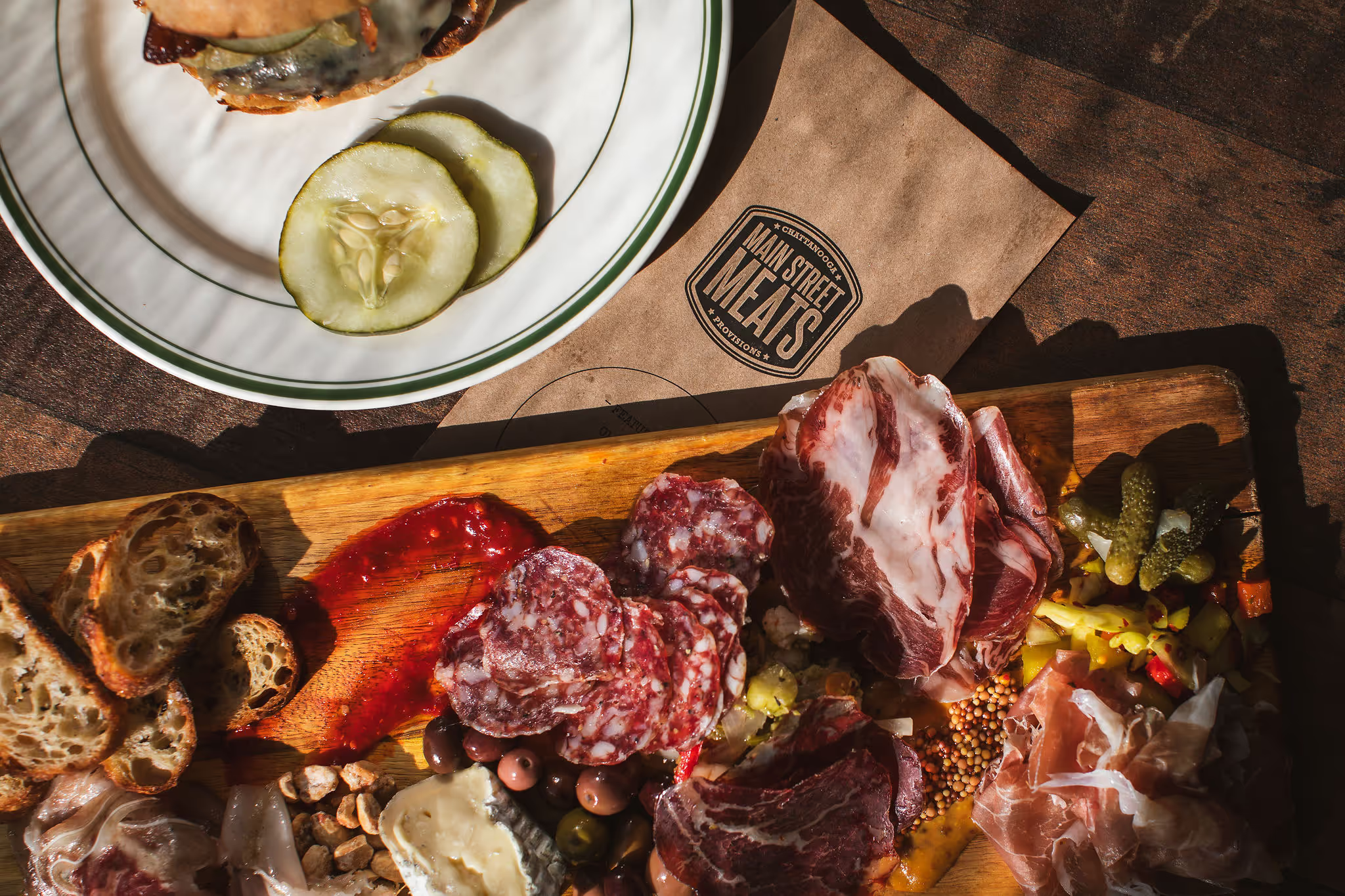
Photo by Sarah Unger
A version of this story originally appeared in Food as a Verb, an independent media company based in Chattanooga, Tennessee, co-founded by author David Cook and photographer Sarah Unger. Food as a Verb is devoted to spotlighting the people and places within the South’s food landscapes.
To eat in modern America is to participate in not-knowing. We encounter the meal on our plates, yet behind that, much is kept hidden from us: how the animals were treated, how the land was farmed, who processed the bodies, and who butchered them.
Some 34 million cattle are slaughtered every year in the US, the conditions of the farm or feedlot or processing plant are obscured. Answers are hidden because, too often, answers are vile and violent. But every so often, we find a window. Through it, we can peer into our meal. We can see the farmers, chefs, butchers, and processors.
Behind the Main Street Meats bar in Chattanooga, Tennessee, there’s a square window, opening up to the butchers working in the back of the restaurant and butcher shop. It’s literal: you can watch the Main Street Meats butchers work.
It’s also symbolic: we can see. Know. And appreciate the story of our meal.
“If people knew how much work goes into that hamburger,” said head butcher Chris LeBlanc, “they’d be shocked.”
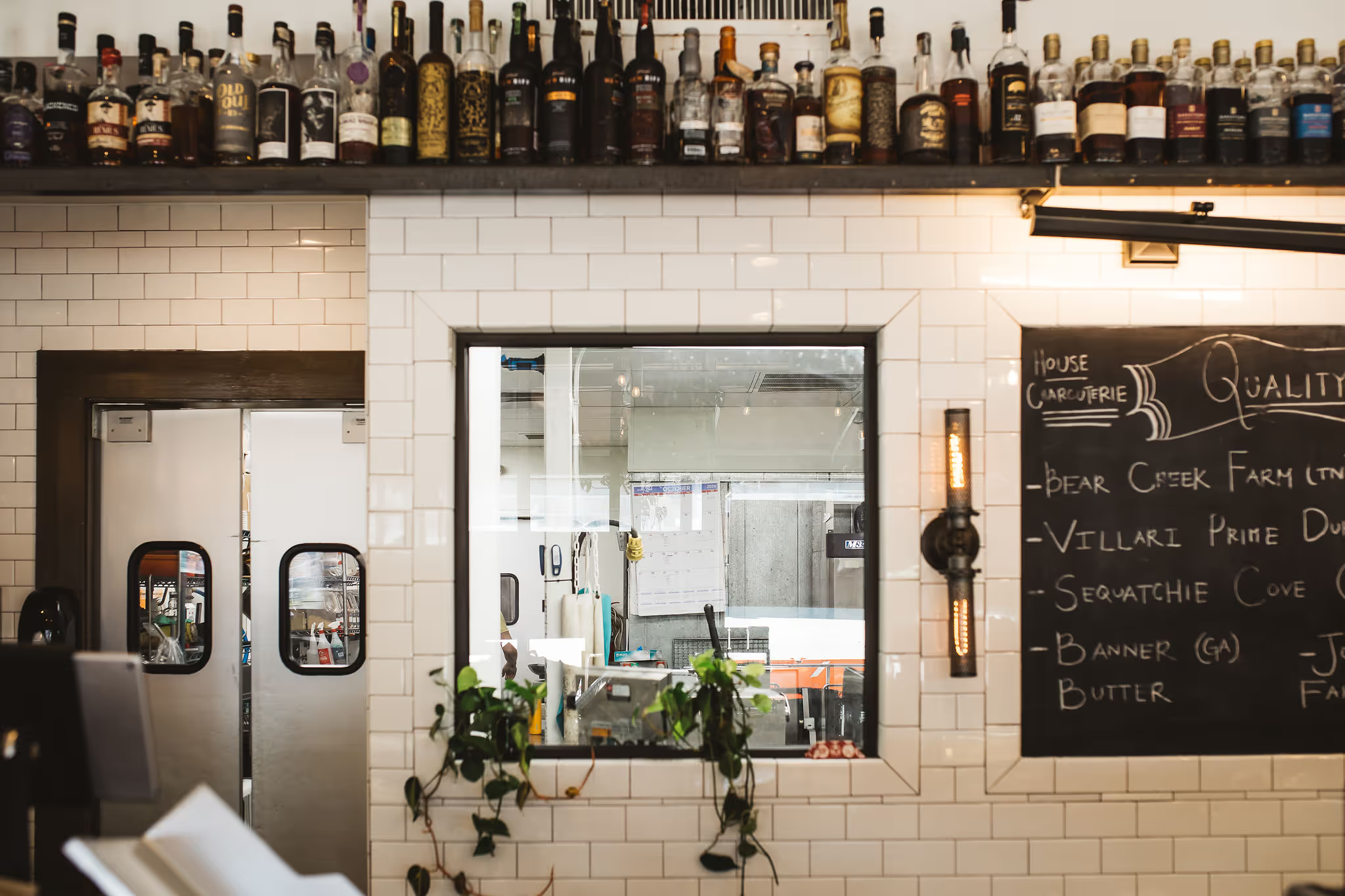
Photo by Sarah Unger
Bill Cherry’s alarm sounds at 4:30 AM. He rises inside the second-floor bedroom of the house he built; outside, Bear Creek runs just beyond the back porch. Beyond that, some two thousand patchwork acres of land his father began to purchase and farm four decades ago at a time when land prices south of Nashville were, well, normal.
Locals whisper of one faraway billionaire who recently flew into town, wrote a kitchen-table check for more money than the sellers dreamed and began to row-crop.
Bill’s a cattle and pig farmer. He worked an office job once—spreadsheets and jammed staplers and swivel chairs—and it almost killed him. So, he returned to farming full time. In 2006, he took over operations of Bear Creek Farm from his father during one of the South’s worst droughts.
“We were hauling city water with a semi twenty-four hours a day,” remembers Bill. “We couldn’t keep up.”
His father had enough. “Don’t want to see another cow in my whole life,” he said. “I’m done. Sell it all.”
So, Bill bought it, then quilted together several plots spread through Williamson and Maury counties. Today, he and his wife, LeeAnn, twin sons, and daughter are doing what very few farming families in America can, or will.
Their work affects and impacts some sixty restaurants and their guests across the South, stretching from middle Tennessee into Georgia and Alabama, all of whom purchase Bear Creek meat, as well as the hundreds of customers who line up each Wednesday at their Farm Store, which typically sells out.
The Cherry family owns and manages Bear Creek Farm with eight hundred Black Angus and two hundred Berkshire, Duroc and Red Wattle pigs. They also own Cherry Meat Co., a USDA processing plant one county over in Chapel Hill, Tennessee.
As both farmers and processors—all of Bear Creek Farm’s cattle and pigs are processed, or “harvested,” at Cherry Meat Co.—the Cherry family manages the entire conception-to-carcass journey. “From birth and conception until it goes to somebody’s hands to cook,” said Bill. Within an industry often vast, cruel, and secretive, they have built the opposite: an intimate form of vertical integration, from conception to harvest, loving stewards over it all. “We do everything from getting animals bred and selecting genetics to calving them out to growing them, weaning them and taking them to our own processing plant,” said Bill.
“I can't think of another example in the Southeast of someone who does it that intentionally,” said Main Street Meats chef and co-owner Erik Niel.
Each month, Cherry Meat Co. process approximately eighty steers, or cows, eighty hogs, and twenty lambs. A USDA inspector has an office inside the plant. “This is our livelihood. This is what our children do. This is what our grandchildren will have the opportunity to do,” LeeAnn said. “We take this shit so seriously.”
LeeAnn Cherry is the type of woman difficult to dislike. She’s tough, like she could hold her own in Yellowstone. So, too, her daughter Paige Alden, a former police officer who manages Cherry Meat Co.
Once, a man called the processing plant with some questions. Paige, new to the job, stumbled over her answers. Frustrated, the caller said something she’ll never forget, “Put a man on the phone.”
“For months on end, I stayed on the processing floor, asking questions so that when people called, they did not ask to speak to a man,” Paige said.
Behind their grit, there is a softness. Even after all these years, when folks aren't looking, LeeAnn still tears up thinking about these cows and pigs. “My eyes still water,” she said. “It's a sacrifice we appreciate.”
From the moment the trailer is unlatched, Paige and LeeAnn work to ensure the least amount of stress—for animals and humans—as possible. “So the animal doesn't feel anything,” said LeeAnn. “That is the ultimate goal.” Not only ethical, it’s good business. In your sirloin, you can taste stress. “When steers are harvested with high levels of cortisol from stress, the meat is affected,” she said. “The cost is affected. Profit is affected.”
When animals arrive at Cherry Meat Co., their last hours of life are defined by multiple safeguards that prevent stress and suffering. Temple-Grandin-inspired pins and sweeps allow animals to lie down at any point. Workers, taught not to rush the animals, also train on proper firing angles so that death is instantaneous. Death comes as a worker fires a bolt gun into the animal’s brain, before firing again if needed. A .22 rifle sits within arm’s reach for backup.
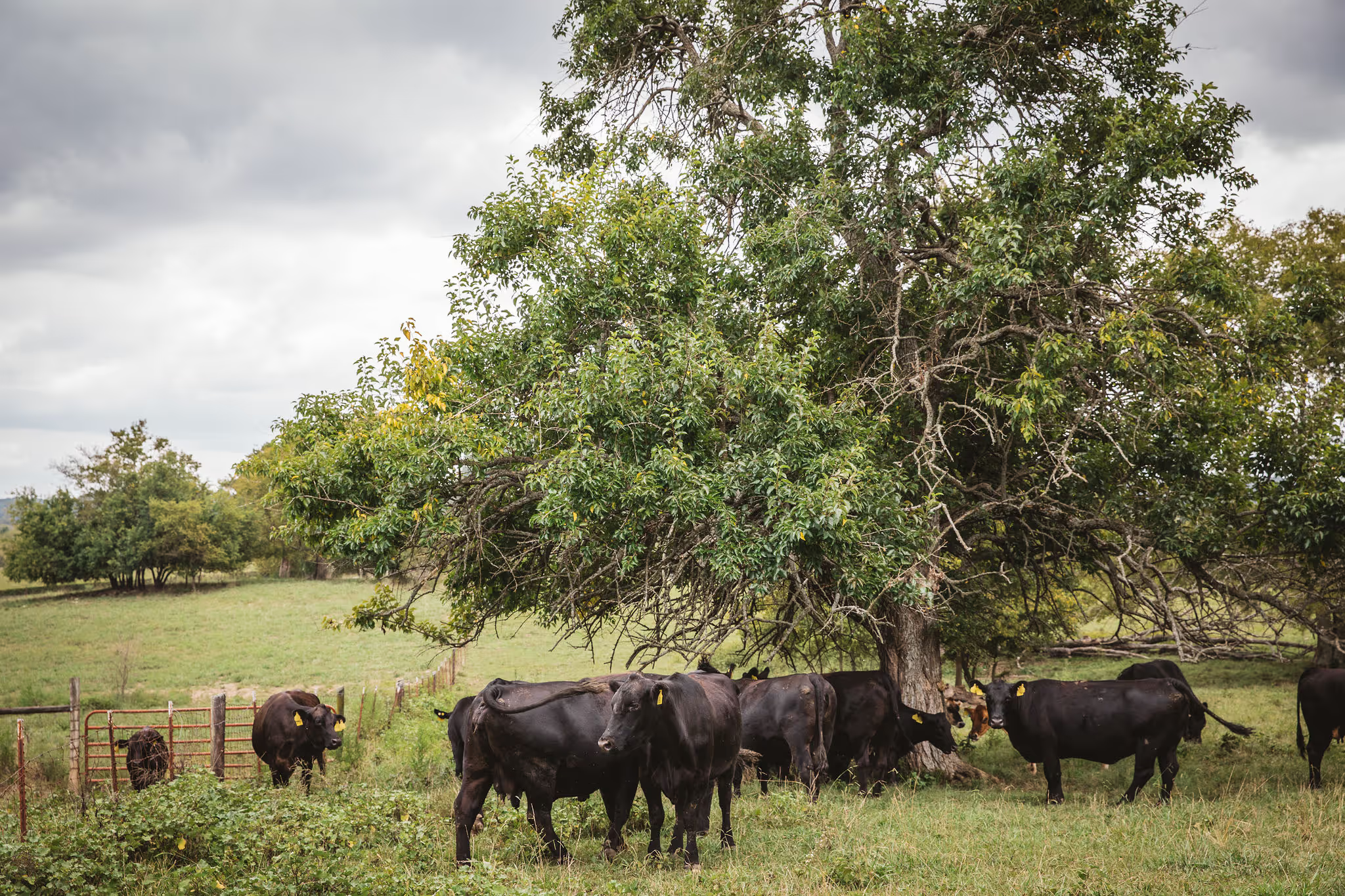
Photo by Sarah Unger
After death, animals are skinned, entrails and heads removed, then halved and quartered.
Witnessing pig carcasses being sawed in half is startling. Yet, there is no sausage, salami or charcuterie served in the country that somehow avoids or skips such a process.
The slaughterhouse industry is historically cruel, with a high turnover rate and critical mental health issues among workers. There’s talk of one slaughterhouse that hired a full-time chaplain. Cherry Meat Co. feels abundantly different. Employees often stay for years, some, decades.
LeeAnn opens a thick steel door to the hanging cooler, full of carcasses. Row after row of pigs, cattle, and lambs hang from steel chains hooked into heels. The bodies are stock-still. The air in the room is so calm—almost like you could whisper one side to the other—that if you gently touched one of the hanging bodies, bumping it with your finger, it may rock back and forth for minutes before stopping.
The cows are headless, but not the pigs, whose eyes still stare unblinking. It is thirty-five degrees.
One feels so small among the enormous, vertical rivers of pink, red, and white fat and muscle. Close your eyes and the room—the air, the atmosphere—feels like an empty chapel at midnight or an opening in the forest, owls overhead, somehow reverent, not brutal.
“Do you hear angels?” LeeAnn asks.
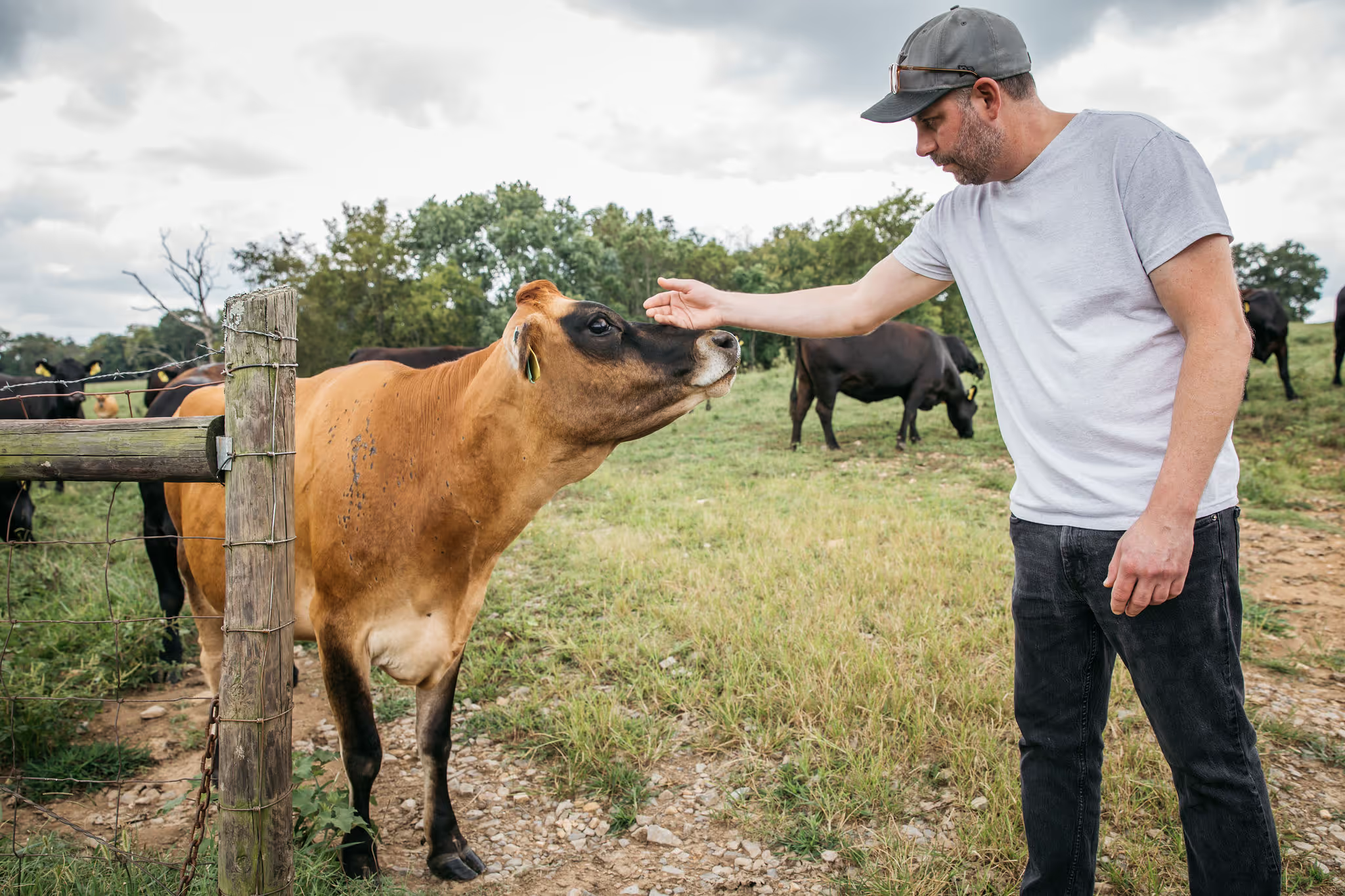
Photo by Sarah Unger
This is one shining pane of the window, the culmination of a system that needs to be honored and seen: Animals raised on rich pasture and open air by farmers acting with intelligence, love, and respect, farming practices that are intentional and beneficial for the land, animals harvested with care by highly ethical and trained people whose entire decision-making process is designed to reduce stress.
“It was paramount for us to control the ending in a humane and ethical way,” LeeAnn said.
That’s why, back in Chattanooga, Chris LeBlanc is waking up so early.
Every other Monday, Chris—head butcher at Main Street Meats—wakes up before the sun, loads up the refrigerated box truck, pulls out of the parking lot with a mug of coffee, maybe a podcast, maybe silence, bound for Cherry Meat Co.
Mid-morning, he arrives, backing the box truck into the Cherry Meat Co. loading dock. They’re expecting him. His order’s ready.
One cow.
Two hogs.
Each halved, then, quartered.
These are the Bear Creek cows and pigs processed at Cherry Meat Co. that Chris and his team will prepare for the Main Street Meats menu.
As he spends his morning at Cherry Meat Co., then onto Bear Creek Farm, where Chris walks the land with Bill, encountering the very cows he will soon butcher, the direct line of relationships becomes clear, his box truck tracing the path from farm-to-plate.
Bear Creek Farm to Cherry Meat Co. to Main Street Meats.
“The relationships we build are the most important thing,” Chris said.
Chris, 43, comes from what he calls “a stereotypical Texas family.” The son of oilmen and ranchers, he’s had a knife in his pocket for decades, with a Texas-forged toughness. At 93, his grandmother still lives on the family’s five-hundred-acre cattle ranch. To protect her garden, she used to shoot stray armadillos from her window.
Drawn to the restaurant industry, perpetually curious about food and food systems, he became a chef in Austin before moving to Chattanooga in 2015.
Stereotypical Texans are big and blustery: Chris is the opposite, more haiku than bluster, not wanting the spotlight, content to work with precision and solitude.
Inside the butcher shop, the quiet stretches like a horizon, a calm that feels grounding and easy. The quiet seems to originate with Chris. “This is my moment of Zen,” he said.
While folks eat and drink nearby, Chris stands with a 10-inch knife above two hundred pounds of Black Angus on the white table before him.
Chris and his team—Aaron Gonzales, Anna Scott, Jeremy Southern—work smoothly and deliberately, using three or four different knives—a 10-inch breaking knife, a six-inch trimming knife, four-inch boning knife, and, every so often, a hacksaw—like sculptors before stone.
Hendrix played differently than Jimmy Page; Steph’s form isn’t Ionescu’s. It’s the same with butchers. There are many ways to break down beef, yet all butchers work towards one singular goal: to extract, withdraw, and resurrect the cuts hidden within. Somewhere inside this Black Angus, there’s a bonanza of future meals. The butcher’s job is to find them.
“You have to know what you're looking for,” Chris said.
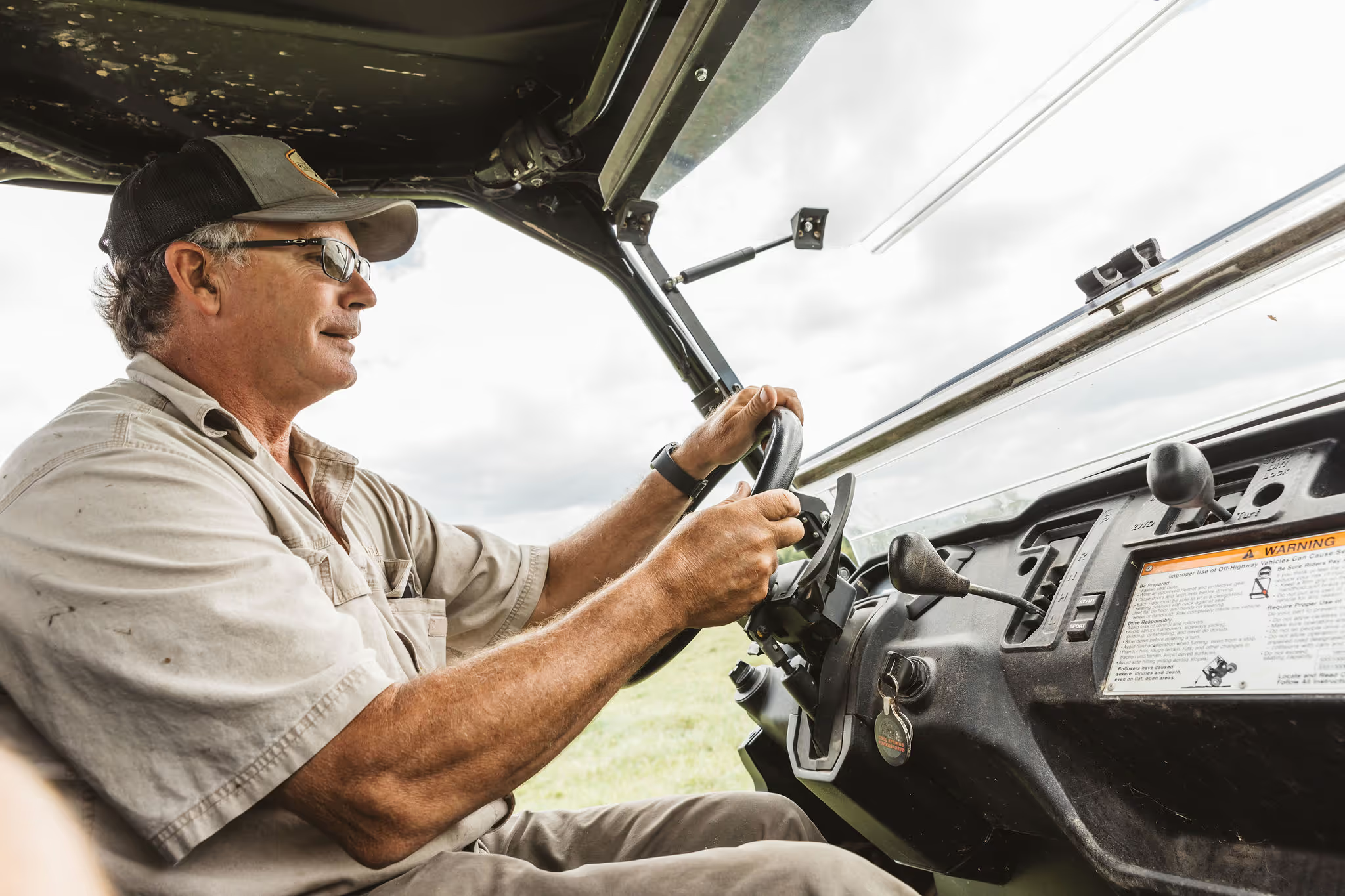
Bill Cherry, Bear Creek Farm, Williamson Co., Tenn., photo by Sarah Unger
When he works, Chris stands over the stark white butcher tables, black Birks on his feet, temp set low, and begins.
There are dozens of cuts of meat within every cow and hog.
“There’s a Denver living inside of this guy here. The teres major? That lives right over here,” Chris said, pointing with his knife towards the Black Angus carcass on the table.
Chris and his team spend the day unearthing a Noah’s ark of meat: tri-tip, teres major, sirloin, ribeye, NY strip, flank steaks, chuck eye, chuck roast, short ribs, flat irons, brisket, ranch steak, ossobuco, oyster steak.
They’re also cutting trim: parts of the cow reserved for ground beef, sliced and saved in trays below the cutting table.
While they work, Chef Erik Niel walks in. He and wife and co-owner Amanda opened a repurposed Main Street Meats in 2015; as Chris continues to work, the James Beard-nominated chef does a little math.
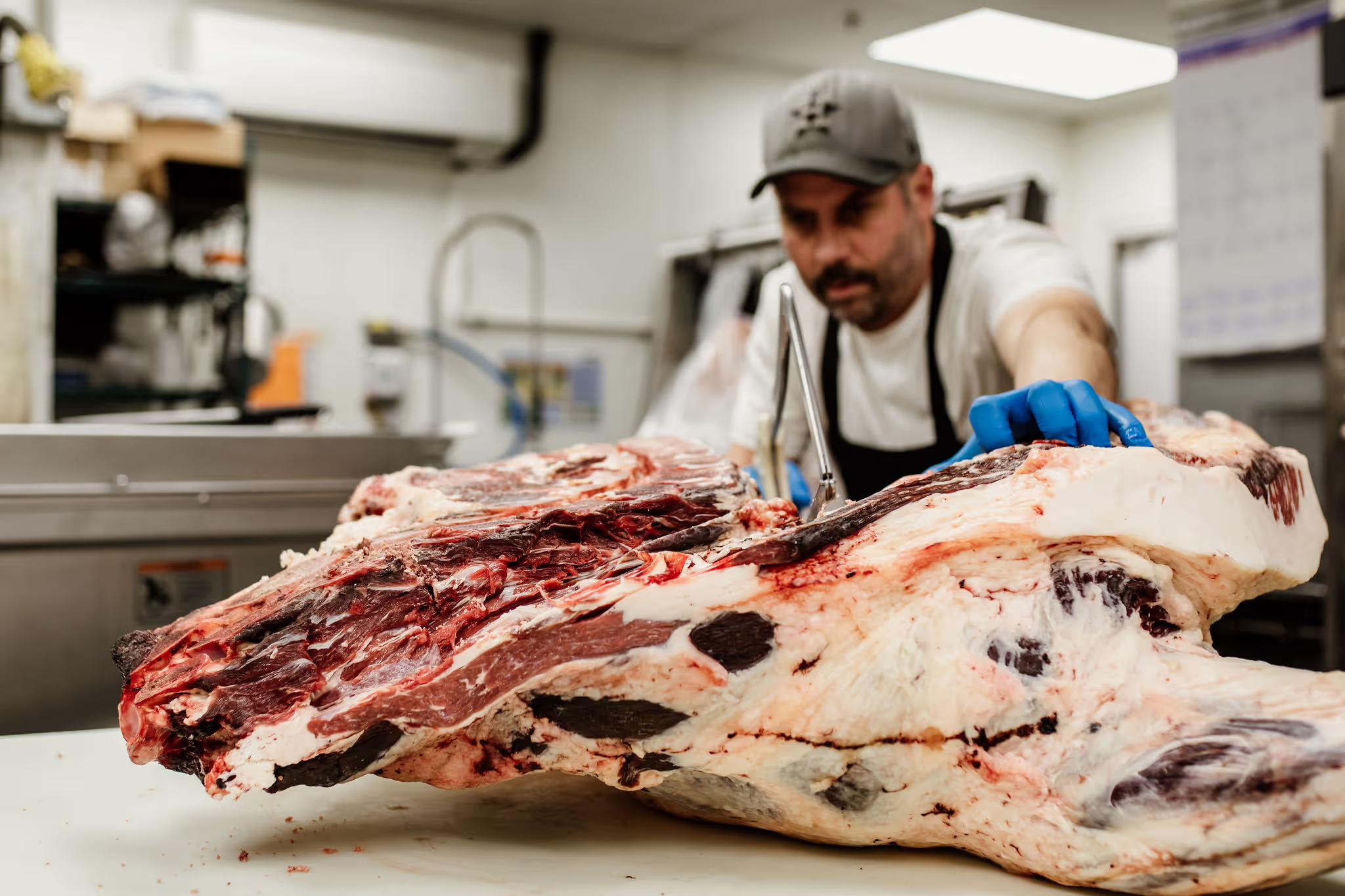
Photo by Sarah Unger
Let’s say a cow weighs one thousand pounds, Erik begins. Of that, two hundred pounds are bones, fifty pounds are waste, five hundred pounds are grind—the term used to describe cuts that become ground beef—leaving 250 pounds for prime cuts.
Within every cow, there are only eight or so pounds of tenderloin, placing any butcher or restaurant owner in a financially perilous position:
“To get forty tenderloins, you need 20 cows,” said Erik. “That’s ten thousand pounds of grind to go through.”
It’s the Main Street Meats guiding principle: no waste.
“Whole animal butchery,” said Chris.
The beef fat gets rendered to make tallow, also used in the kitchen’s fryers. Bones become beef stock, then, reduced with red wine, become bordelaise.
Other cuts—like eye-of-round—are hung to dry, becoming bresaola. Hog fat is rendered into lard. Bones become pork stock, skins become pork rinds, trim becomes sausage and salami.
Pig heads are used for porchetta di testa. Jowls can become guanciale. Loins become lonzino, coppas become capicola.
Hog muscles become trays of charcuterie, a French term describing an ancient way of preserving meat preservation and using all parts of the animal.
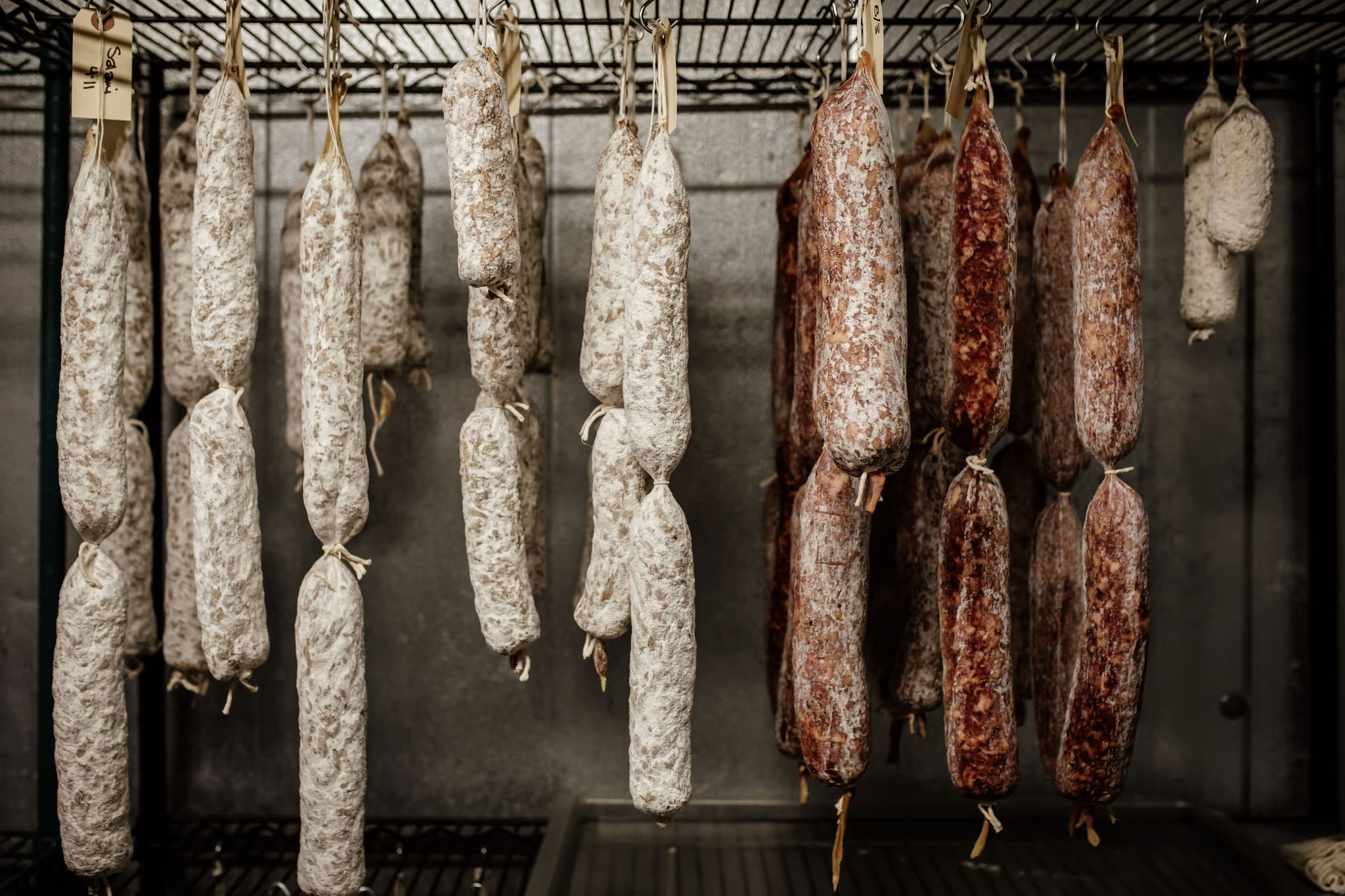
Photo by Sarah Unger
Inside the “salami cave,” a dedicated walk-in cooler, rows of salami hang like chimes and ornaments, as the mold inoculates and covers like a soft white blanket.
The work is scientific; ribs and short loins dry-age in the cooler for forty-five or more days, until exactly right. Grams of sea salt and sugars are measured with precision.
Precision is a form of respect.
“We try not to let anything go to waste,” said Chris. “A good butcher is someone who does that.”
When the Niels opened Main Street Meats, they were criticized for a $9 hamburger, which now sells for $16. Yet cheap burgers can reinforce a cheap system with potentially devastating consequences: from recalls to antibiotic resistance to chemical run-off to animal and human abuse.
This one thousand-pound cow costs $5.15-per-pound before anyone even picks up a knife. Add in expenses and labor and $5.15 can quickly become $15.
“You’re learning how to do it and not lose your ass on one thousand pounds of cow,” said Erik. “I find it fascinating, man.”
It’s Saturday night at Main Street Meats. Servers carry out plates of sausage and tallow fries and bartenders pour jalapeno margaritas and Jack White’s on the stereo as folks pick up forks and knives, laugh and clink glasses. It’s loud and big-hearted and delicious.
A woman at the bar orders a burger. On her plate, you can touch a line of relationships stretching from Main Street all the way back to a two thousand-acre farm, a do-you-hear-angels processing plant south of Nashville, then to the Zen quiet of a butcher shop.
“Our job has always been to respect the ingredients and all the hard work that went into raising or growing them,” Chris said. “In this case, we do it by utilizing everything.”
That literal square window behind the Main Street Meat bar, opening up to the butcher shop, it’s both a literal and symbolic window; guests can see into the butcher shop where Chris works. If we look closely, we can see far beyond it, too. We can see the farmers, chefs, butchers, and processors—their ethics, experiences, the way they hold a knife or walk the land. We see respect. Chris said, “Respect for farmers, respect for the animal that gave its life, respect for our customers.”
This article was supported by The Julia Child Foundation for Gastronomy and the Culinary Arts.





